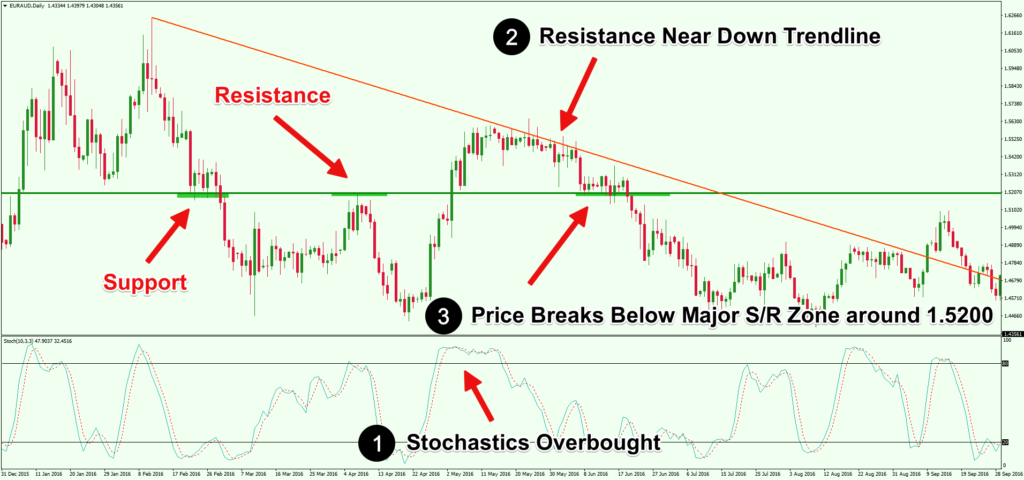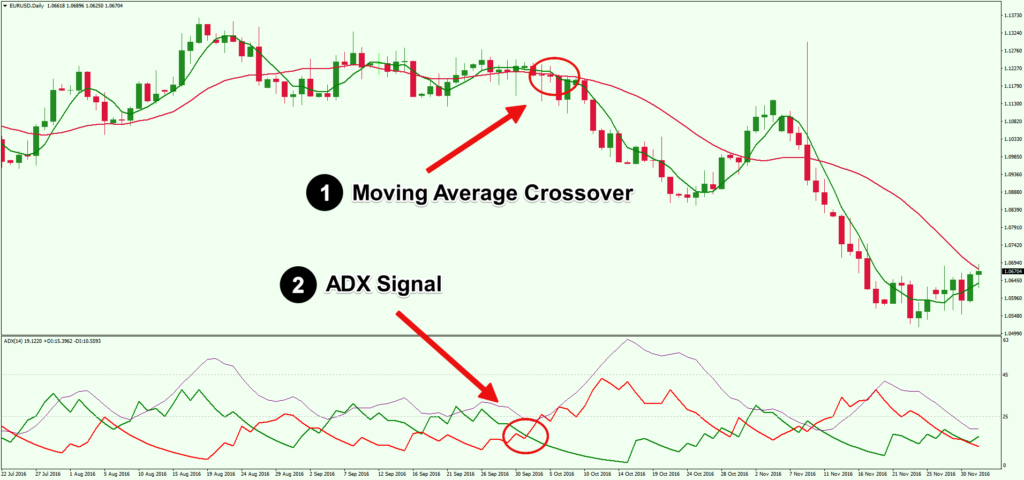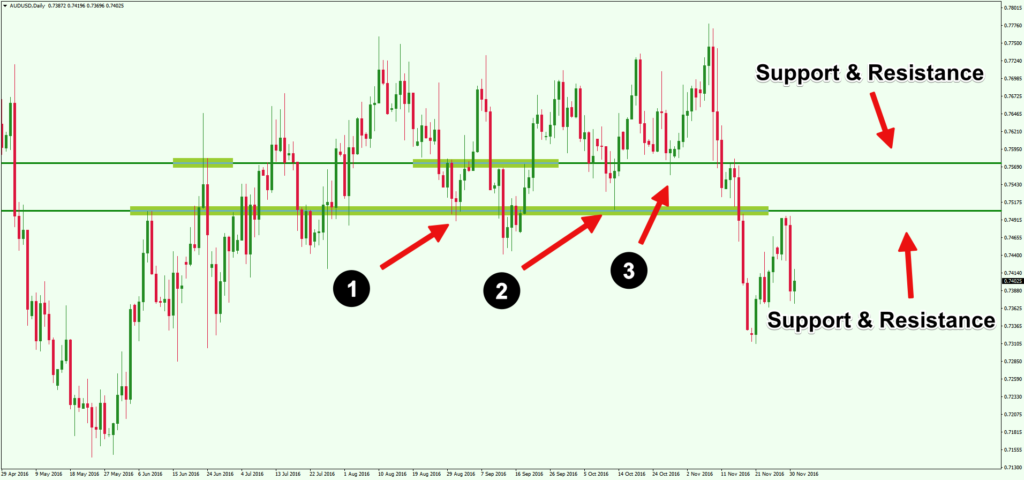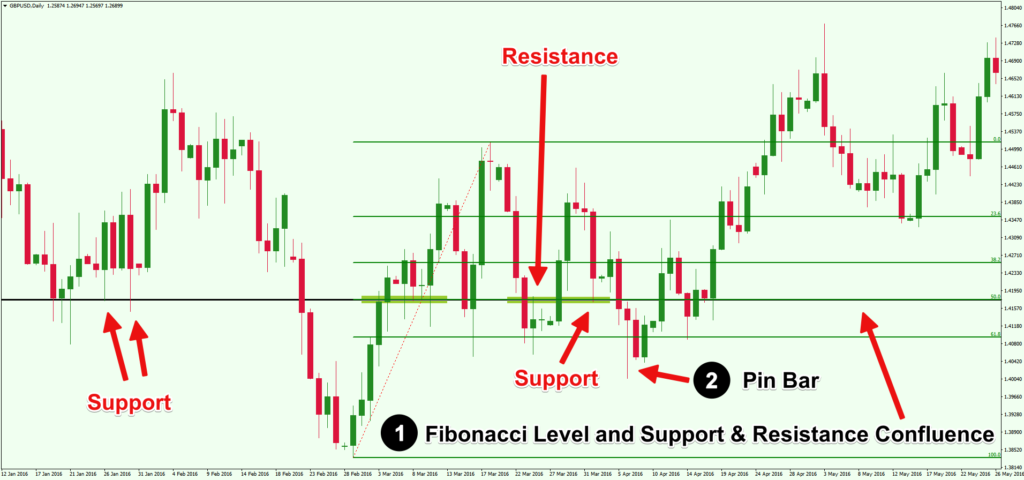Trading foreign exchange currency pairs is often considered an art rather than a science because it requires the use of experience and intuition to generate ongoing profits.
To become successful as a foreign exchange trader, you need to have an edge that enables you to make a consistent profit. An edge that will allow you to earn enough money when you are winning, and lose less than your winnings, when you end up losing money on a trade. Trading with confluence can give you the increased edge that you need to succeed in the foreign exchange market.
Firstly, let me take a moment to explain what confluence is. In a nutshell, confluence trading is simply combining more than one trading technique or analysis to increase your odds of winning on a trade.
For example, technical analysis is the study of using past price patterns to forecast future directional movement of a currency pair or any other underlying asset. Hence, if you use a single technical analysis tool which has, for instance, a 60 % accuracy rate of predicting the price movement, and then, apply a second, non-correlated technical analysis tool to filter your decision further, then you would be increasing your odds of winning. This is the basic idea behind trading Forex confluence. And there are many ways a trader can apply the concept of confluence into their trading plan.
Trading Foreign Exchange with Technical Analysis Confluence
A technical confluence occurs when you find a trade setup using multiple technical trading tools, and all of these independent forms of analysis indicate a similar impending directional price movement.
For example, when you are using an oscillating technical indicator like Stochastics, it can generate an overbought market condition signal near a major resistance zone.
This resistance zone could happen to be a Big Round Number (BRN) as well. If you place a sell order based on these several technical factors, then you are essentially utilizing technical analysis confluence.

Figure 1: Confluence Trading Using Stochastics Indicator, Trend Line, and S/R Levels
This is the daily chart of the EURAUD forex pair. In this example, we can see that the Stochastics indicator was clearly trading above the 80 level (labelled number 1).
Forex traders consider such market conditions as an indication of a possible overbought market. When the market is in an overbought market condition, it signals that the price could soon reverse the course of the prevailing trend or likely start a retracement move in the opposite direction.
Secondly, as soon as the EURAUD price reached the 1.5575 level, it formed a downtrend line (labelled number 2), where the price penetrated above the trend line several times, however, failed to close above it on the daily time frame. The formation of the downtrend line signaled the diminishing bullish momentum above this price level.
Next, you can see the EURAUD price respected the 1.5200 level as a major psychological pivot zone (labelled number 3), where the market previously found both support and resistance.
Many professional forex traders consider price levels ending with round figures to act as important psychological levels, so this support and resistance level had special significance.
When there is price confluence at a support or resistance level, it often attracts large-scale institutional traders, market makers, and other participants who find these price levels opportune areas to place their pending orders. Thus, buyers and sellers engage in a sort of tug of war around these types of major confluence price levels.
The trade setup in figure 1 is showing a confluence on the price chart of three different technical factors – 1) a technical indicator signaling a possibility of an imminent change in trend, 2) formation of a downtrend line restricting the EURAUD price from moving upwards, and 3) a price squeeze favoring the downside, which also happens to be around a psychologically important big round number.
When the EURAUD price closed below the pivot zone around 1.5200 on June 15, 2016, it signaled a bearish move. If you had placed a sell order as soon as the price closed below the 1.5200 level, and kept your stop loss above the downtrend line, around 1.5415, then this particular trade could have yielded around 700 pips over the next two weeks.

Figure 2: Using Different Technical Analysis Indicators to Find Forex Confluence
Let now look at the daily EURUSD chart in figure 2. Here we applied two different technical analysis indicators to identify a confluence: 1) a simple moving average (SMA) crossover of SMA (5) and SMA (21), and 2) the Average Directional Movement (ADX) indicator with default settings.
First, on October 2, 2016, the ADX (Average Directional Index) indicator (labelled number 1) generated a sell signal when -DI crossed above the +DI line. At this point, you could place a sell order based on that single factor. However, if you closely examine the previous few buy and sell signals generated by the ADX indicator, you can see that due to a range bound market condition, most of these signals did not result in any significant directional movement of price.
Hence, if you filter the ADX signal by using a trend analysis tool like a moving average crossover, it will likely increase the odds of catching an emerging trend.
Four days after the ADX signal, you will notice the SMA 5 crossed below the SMA 21 (labelled number 2). Within three days of the moving average crossover, the EURUSD started a downtrend that pushed the price lower by around 350 pips.
By applying confluence on the price chart, you could have entered the market at the right time and made a profit on this trade.
Be Careful About What Technical Analysis Tools You Use to Trade Confluence
Using a confluence signal that incorporates several technical analysis methods is a very powerful trading strategy in your arsenal. However, when developing and using confluence based trading systems, you need to have a thorough understanding of the indicators you are using.
For example, in figure 2, we used two sets of indicators, but note that both of these are trend following indicators. If we used an oscillator like Stochastics with ADX, the oscillator might have generated an oversold signal when the downtrend was about to start. Such contradictory signals could turn out to be confusing and may prove to be a hindrance when trading in real time. This is especially true, in the lower time frames, where the price can move very fast in a short period of time.
Therefore, when you apply a confluence based strategy to trade forex, you should be very careful in how you pick your technical analysis tools. Whenever possible, stick to using trend following indicators during trending market conditions.
On the other hand, if the market appears to be range bound, use tools suitable for a consolidating market, such as oscillators. But be careful of redundancy – essentially that you are not combining highly correlated trading indicators and considering that as a valid confluence.
Using Price Action to Trade Forex Confluence
When trading Forex confluence, you don’t necessarily need to combine complicated technical indicators or several technical analysis tools. Instead, you can use simple price action confluence and bar patterns to successfully trade as well. And trading with simple price action confluence is what I prefer the most.
In the following section, we will discuss how you can use the confluence of price action with simple support & resistance levels.

Figure 3: Using Pin Bar Price Action to Trade Forex Confluence
Let’s turn our attention to Figure 3 above of the AUDUSD daily chart. Using this chart example, we will be discussing how you can combine simple price action bar patterns in conjunction with major support and resistance levels.
Take note that we have identified two major pivot zones that acted as both support and resistance levels during the second half of 2016. First, is the 0.7500 big round number. The second major support & resistance level is a bit interesting, as it is the 0.7575 level.
Combination numbers like 0.7575, or 1.1111, 1.3366, 0.8888, et al., are considered psychologically special pivot zones, simply because these figures are easy to remember for traders.
As such, there can be large pending orders around these levels. These levels act as somewhat of a self-fulfilling prophecy, if you will.
As you can see, for the AUDUSD, the 0.7575 did act as a major pivot zone, where price found both support and resistance on some occasions.
When we closely examine the three pin bars identified by number 1, 2, and 3, we can see that all of these bars have formed after touching either, or both, of the two major support & resistance zones we identified on the price chart.
While the first pin bar is technically a pin bar, it has a very small tail, and I would not recommend trading it. However, pin bar number 2 and 3 are both decent looking bars with long tails.
If you simply placed a pending BUY order above the high of either of these two bars and held until the first close below the previous candle, it would have resulted in a profitable trade.

In this next example, we are going to take the idea of support and resistance swings and supercharge it by combining it with various Fibonacci retracement levels. In figure 4, we have a GBPUSD price chart. Note how the 1.4175 level perfectly aligned with the 50% Fibonacci retracement level. This type of price action confluence, where you see support and resistance zones that overlap Fibonacci levels, are extremely powerful signals.
As noted earlier, the logic behind combining several different price levels of varying importance is that more traders watch these levels and they place a significant amount of pending orders around these areas of price confluence. Hence, when the market breaks above or below these types of multi-layered confluence levels, the price moves very fast in the direction of the breakout.
Because the price momentum accelerates sharply from these areas, trading price action bars like pin bars or outside bars around these types of confluence levels can be quite lucrative for the forex trader.
As you can see, in figure 4, a break above the bullish pin bar (labelled number 2) prompted the GBPUSD bullish momentum to accelerate, and the price soon climbed to the 23.6% Fibonacci retracement level. If you had placed a pending Buy Stop order above the high of this bullish pin bar based on this technical confluence, it would have turned out to be a profitable setup.

Figure 5: Using Confluence of Trend Line and Support & Resistance with Price Action
We have previously touched on how you can use the confluence of technical indicators and trend lines. Now we will illustrate how you can combine trend lines with support & resistance levels to trade price action confluence as well.
In figure 5, you can see that the 1.2900 level on the USDCAD acted as a support area on July 21, 2016 (labelled number 1), then subsequently, on July 28, 2016, this same level held the USDCAD price from falling further down (labelled number 2). The next day, on July 29, 2016, the USDCAD penetrated below the 1.2900 level but ended up forming a bullish pin bar (labelled number 3), which indicated the continuation of the uptrend.
If you had placed a buy order just above the high of this pin bar based on this three-factor confluence, this trade would have earned quite a few pips, to say the least.
The point of all these example trades is to provide your ideas for combining trend lines, support & resistance levels, price action bars, and other types of analysis to form a confluence based trading strategy. When you take your trades based on the power of the confluence, you end up yielding a better result from your trades in the long run.
Combining Simple Fundamental Analysis with Technical Confluence
Besides using the power of technical confluence, you can also apply sound fundamental analysis with technical charts to develop a comprehensive trading strategy.
Most professional Forex traders follow economic calendar events, such as key overnight interest rates, employment rates, unemployment benefit claims figures, consumer price index, and various other economic indicators.
You do not have to be an Economist to understand the basic fundamental data that is most relevant for traders. Just knowing the previous data points, what the consensus forecast was, and how the actual figure deviated or did not deviate from the forecast or expectation can help us gauge how the economic news release will have an impact on the respective currency pairs.
For example, if an announcement comes out for the US Dollar, and the numbers come in with a poor reading, and you are already bearish on the Dollar due to technical chart factors, then this combined analysis will further bolster and validate your trade bias.
So, in this case if you plan to short the Dollar, then you would be doing so based on combined a fundamental and technical view of the US Dollar.
Many times, by combining basic fundamental data with technical analysis, you can multiply your odds of winning and improve your win rate dramatically.
Conclusion
There is no hard and fast rule about how you can harness the power of trading with confluence. You can combine several technical indicators to find a confluence and take the trade when all these indicators line up. Alternatively, you can simply identify major support & resistance levels and wait for the price to form a common price action pattern around these levels, and take the trade in the direction of the price action momentum. You can also consider fundamental factors and combine it alongside technical analysis to improve the accuracy of your trades.
Keep in mind that support and resistance formed around key levels, such as big round numbers and Fibonacci retracements are always important because these are pivot zones that many traders are watching. You should always try to identify such areas of importance before placing a trade on the market.
Finally, regardless which method of Forex confluence you decide to use while developing your personal trading strategy, you should always diversify your arsenal and combine various technical and fundamental factors to increase your odds of winning.